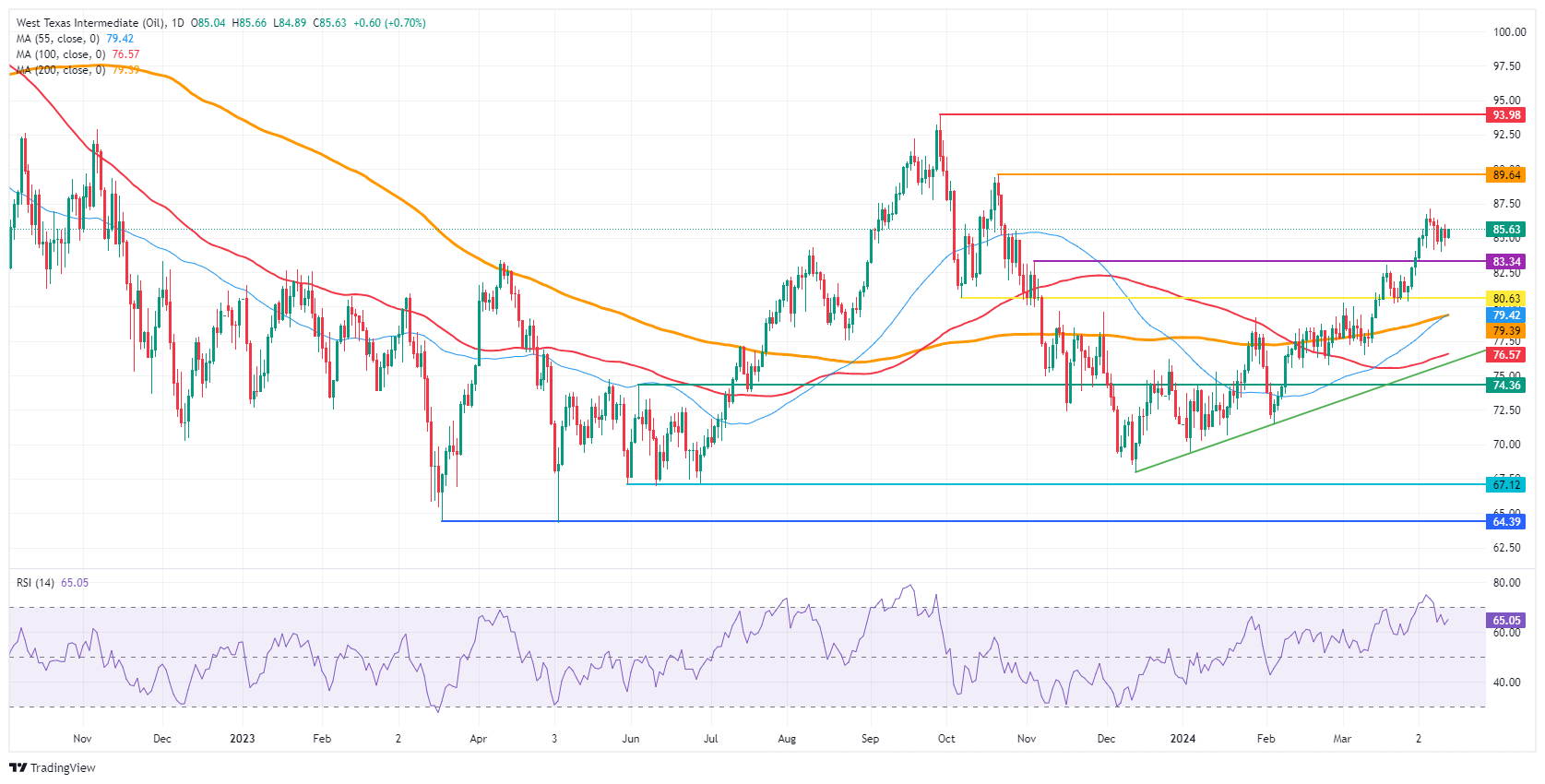- WTI is trading above $85 again, after this week's fluctuations.
- Oil price rises nearly 1% despite EIA forecasting negative outlook for oil demand.
- The US Dollar Index is approaching 106.00 and marks a new five-month high.
Oil prices rise again on Friday after Thursday's small decline of 0.75%. Commodities are rising again, driven by geopolitical tensions and despite the US dollar stretching higher for the fourth consecutive day this week. Meanwhile, the International Energy Agency (IEA) has cut its oil demand forecasts for this year and next, anticipating slower growth in 2025, due to a bleak economic outlook and the growing market share of electric vehicles in the global automobile market
For its part, the US Dollar is posting a staggering 1.8% rally on the Dollar Index (DXY), after markets increasingly expect a wider interest rate differential between the Federal Reserve (Fed) and other banks. central. This rate differential is separating countries (and ergo the local currency) where central banks absolutely need to cut from those where cuts are not currently needed. Strong US economic data points to the US as the leader of countries where, under current conditions, rate cuts are not needed at all.
Crude oil (WTI) is trading at $85.77 and Brent at $90.36 at the time of writing.
Oil News and Market Movements: Retaliation Is Coming
- OPEC and IEA oil demand outlooks diverge substantially. While the IEA forecasts lower demand in 2024 and 2025, OPEC said on Thursday it is closely monitoring summer demand as it would not be able to cope with any unforeseen rebound in demand.
- Furthermore, according to the IEA report this Friday, more than 3 million barrels per day will be added from non-OPEC projects, with Brazil as the main contributor.
- OPEC production increased by 110,000 barrels per day compared to February data. According to Bloomberg, Saudi Arabia and Kuwait were responsible for this small rebound.
- More and more local governments in Europe, the US and Israel are warning of possible retaliation from Iran.
Oil Technical Analysis: Side Entry
Oil prices remain high with tensions in the Middle East about to enter a new dynamic. After Iran vowed to retaliate against Israel or any US assets in the region, tensions are rising as such an attack could drag the entire region back into a long dispute with the risk of interruptions in the supply of oil. Meanwhile, the bearish IEA report claims that Brazil will soon add substantially more non-OPEC oil to the markets. Although Brazil was scheduled to join OPEC earlier this year, that inauguration has yet to occur.
If last week's high at $87.12 is broken, the $90 area should be within reach. A small barrier in the way is $89.64, the October 20 high. Should tensions escalate in the Middle East, it is possible that $94 could be reached, which could be a new 18-month high.
On the downside, $83.34 is the first level to watch after a very clean breakout and test of support on April 1-2. If not held, $80.63 is the next best candidate as a fundamental support level. A little softer, the convergence with the 55-day and 200-day SMA at $79.32 should stem any further decline.

WTI Crude Oil: Daily Chart
WTI Oil FAQ
What is WTI oil?
WTI oil is a type of crude oil that is sold in international markets. WTI stands for West Texas Intermediate, one of the three main types that include Brent and Dubai crude. WTI is also known as “light” and “sweet” for its relatively low gravity and sulfur content, respectively. It is considered a high-quality oil that is easily refined. It is sourced in the United States and distributed through the Cushing facility, considered “the pipeline junction of the world.” It is a benchmark for the oil market and the price of WTI is frequently quoted in the media.
What factors determine the price of WTI oil?
Like all assets, supply and demand are the main factors that determine the price of WTI oil. As such, global growth can be a driver of increased demand and vice versa in the case of weak global growth. Political instability, wars and sanctions can alter supply and impact prices. The decisions of OPEC, a group of large oil-producing countries, is another key price factor. The value of the US Dollar influences the price of WTI crude oil, as oil is primarily traded in US dollars, so a weaker Dollar can make oil more affordable and vice versa.
How do inventories influence the price of WTI oil?
Weekly oil inventory reports published by the American Petroleum Institute (API) and the Energy Information Agency (EIA) influence the price of WTI oil. Changes in inventories reflect the fluctuation of supply and demand. If the data shows a decline in inventories, it may indicate an increase in demand, which would drive up the price of oil. An increase in inventories can reflect an increase in supply, which drives down prices. The API report is published every Tuesday and the EIA report the next day. Their results are usually similar, with a difference of 1% between them 75% of the time. EIA data is considered more reliable since it is a government agency.
How does OPEC influence the price of WTI oil?
OPEC (Organization of the Petroleum Exporting Countries) is a group of 13 oil-producing nations that collectively decide member countries' production quotas at biannual meetings. Their decisions often influence WTI oil prices. When OPEC decides to reduce quotas, it can restrict supply and drive up oil prices. When OPEC increases production, the opposite effect occurs. OPEC+ is an expanded group that includes ten other non-OPEC member countries, including Russia.
Source: Fx Street
I am Joshua Winder, a senior-level journalist and editor at World Stock Market. I specialize in covering news related to the stock market and economic trends. With more than 8 years of experience in this field, I have become an expert in financial reporting.







